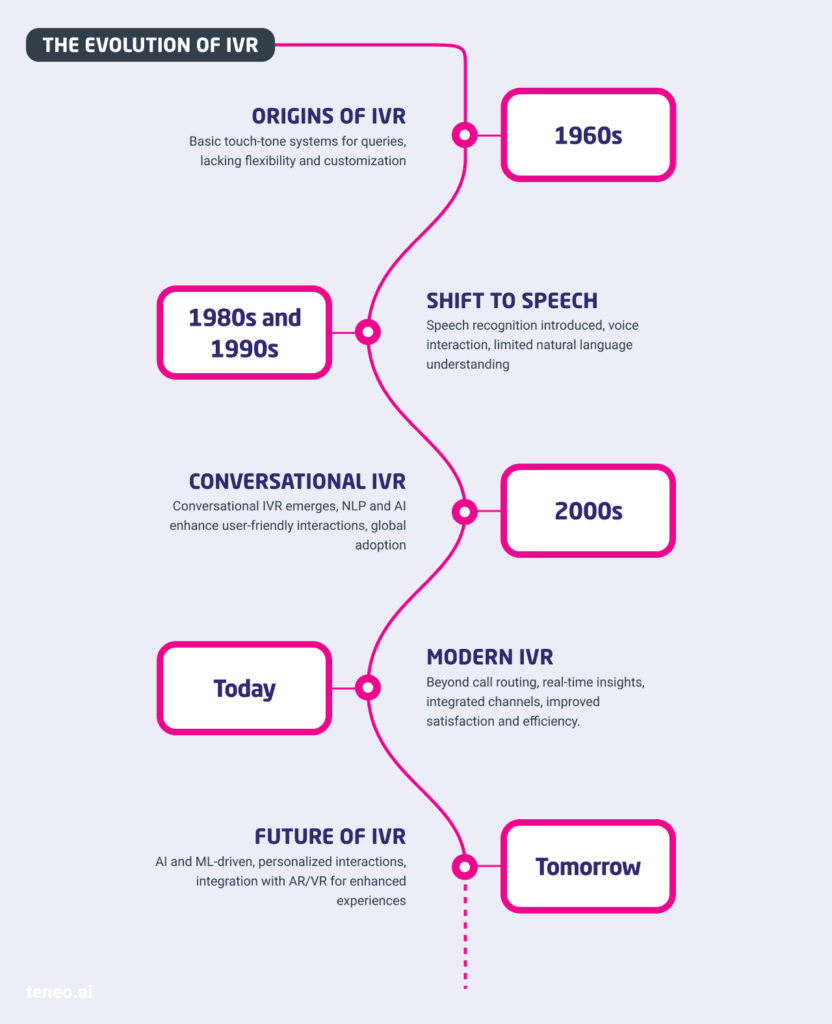What is the significance of IVR in Customer Service?
The 2000s marked a significant shift in Customer Service and IVRs with the emergence of conversational IVR systems. Leveraging advancements in NLP and AI, these systems made interactions more fluid and user-friendly. In this blogpost you will get an introduction to IVR and it’s impact in modern customer service.
Understanding the Evolution of IVR
Interactive Voice Response (IVR) systems have been an integral part of customer service for decades. From the beginnings as tone-based systems to the advanced conversational interfaces we see today, IVR technology has undergone a significant transformation. This post will trace the history and technological advancements in IVR, offering insights into its evolution and its impact on customer service.
The Early Days of IVR
The origins of IVR can be traced back to the 1960s when businesses began to explore automated systems to handle customer queries. These early systems were basic, relying on touch-tone inputs from users to navigate through pre-defined menus. While they offered some level of automation, they were often rigid and lacked the flexibility to cater to diverse customer needs.

The Shift to Speech Recognition
As technology advanced, so did IVR systems. The 1980s and 1990s saw the introduction of speech recognition capabilities. This allowed users to interact with IVR systems using voice commands, making the experience more intuitive. However, these systems were still in their infancy, and understanding natural language was a challenge.
Conversational IVR: A Game Changer
The 2000s marked a significant shift in IVR technology with the emergence of conversational IVR systems. Leveraging advancements in Natural Language Processing (NLP) and Artificial Intelligence (AI), these systems could understand and process natural language, making interactions more fluid and user-friendly. Businesses globally began to recognize the potential of conversational IVRs, leading to widespread adoption.
Modern IVR Systems: Beyond Call Routing
Today’s IVR systems are not just about routing calls. They are equipped with features that enhance user experience, provide real-time insights, and integrate seamlessly with other customer service channels. For instance, companies like Telefonica have successfully implemented modern IVR systems, witnessing significant improvements in customer satisfaction and operational efficiency.
The Future of IVR in Customer Service
As technology continues to evolve, so will IVR systems. With the rise of AI and Machine Learning, future IVR systems are set to become even more intuitive, personalized, and efficient. Integration with other emerging technologies, such as Augmented Reality (AR) and Virtual Reality (VR), will further enhance the customer service experience.
The journey of IVR in customer service has been one of continuous evolution and innovation. From basic tone-based systems to advanced conversational interfaces, IVR technology has come a long way. As businesses continue to prioritize customer experience, the role of IVR in shaping customer interactions will only become more significant.
Continue Reading:
- Customer Service IVR: A Complete Guide
- Introduction to IVR in Modern Customer Service (You are here)
- Benefits of Customer Service IVR
- Challenges and Limitations of Traditional IVR Systems
- Integrating IVR with Other Customer Service Channels
- Feedback Mechanisms in Customer IVR
- Customer Service IVR Case Studies
- Top IVR Venders in 2025
- The ROI of Implementing a Modern IVR System in Customer Service
- The Future of IVR in Customer Service

